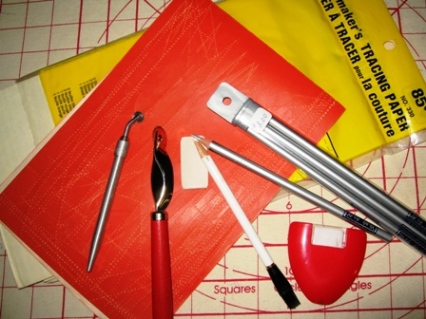- Home
- Small Sewing Tools
- Marking Tools
Choosing the Right Marking Tools
A staple of marking tools in any sewing room used to be tracing paper and a tracing wheel. Apparently, it's pretty hard to find decent tracing paper these days. The modern type seems to be chalk based and doesn't work as well as the old kind. If you get a chance to get some vintage tracing paper, snap it up! Nothing works better for some application. When you use it, use the closest colour of tracing paper to your fashion fabric you can get away with and still see your marks. White tracing will disappear under a hot iron. The other colours are more permanent. So be careful where you use it!
Tailors chalk removes completely by simply brushing it off. I find tailors chalk one of the easiest and safest marking tools to use. Avoid the kind that has a waxy base—use only the chalky kind. Tailors chalk is also available in pencil form, and as a power you put in a tool, like a Chacoliner, that you run over where you want to mark. A thin line comes out of the tool, and is still easily removed by brushing away. Tailors chalk comes in white, as well as pink and light blue.
Quilters silver pencils may work, depending on your fabric type and colour. They are meant to work well on cottons, such as quilters use, and may not show up on all colours.
 Marking Tools from left to right, two tracing wheels, a block of tailors chalk, tailors chalk pencil, tailors chalk power in a marker, quilter's silver pencils. Underneath, is dressmakers tracing paper.
Marking Tools from left to right, two tracing wheels, a block of tailors chalk, tailors chalk pencil, tailors chalk power in a marker, quilter's silver pencils. Underneath, is dressmakers tracing paper.Thread tracing or tailors tacks are a non-invasive way to mark fabric. This is the best marking method to use for tailoring on wool fabric, or anywhere on fine silk or other fabric that might be damaged by other marking methods. Use a fine needle and basting thread—the thread is easily removed when you don’t need it anymore.
**AVOID** marking with a graphite pencil. These would be like ordinary writing pencils, but sometimes are sold to quilters as mechanical pencils with fine lead. I have had some very unfortunate experiences with graphite—it smears where you don’t want it to go, and it’s nearly impossible to get out—even with so-called “fabric erasers”. Using pencil lead is an old holdover from way back when—lead pencils were the only sewing tools people had to mark with and they used what they had. We have much better choices today!
Disappearing Markers are handy. They come in either the purple kind, which disappears in a few hours to several days. Or the blue kind, which must be removed with water. You can remove the air-drying kind with water also, if you are in a hurry. Be careful with these markers - I've heard horror stories about the marks coming back again. One such story involved a white wedding dress where the sewer had marked all over for decorations on the dress with a disappearing marker. To her horror, they reappeared at the wedding as brown marks all over the gown! I only use these markers in the seam allowances or inside the garment, where they won't be seen if they come back.
Frixion Pens are pretty handy too. They are popular with quilters for marking, but again, I'd just be careful marking with a Frixion pen on anywhere that will show on the finished work. The pens come in different colours and the marks disappear under a hot iron. You can also buy marking pens in sewing shops that basically work the same way. As long as you are careful where you use these pens, you may find them very handy.
Return from Marking Tools to Small Sewing Tools Page -->
Return to Home Page -->